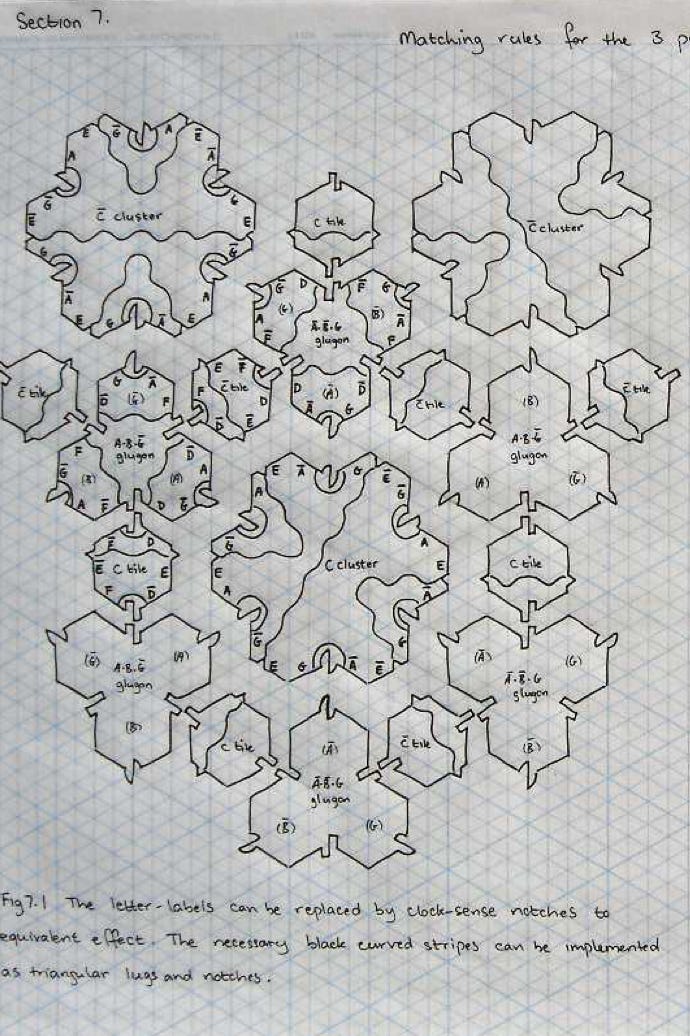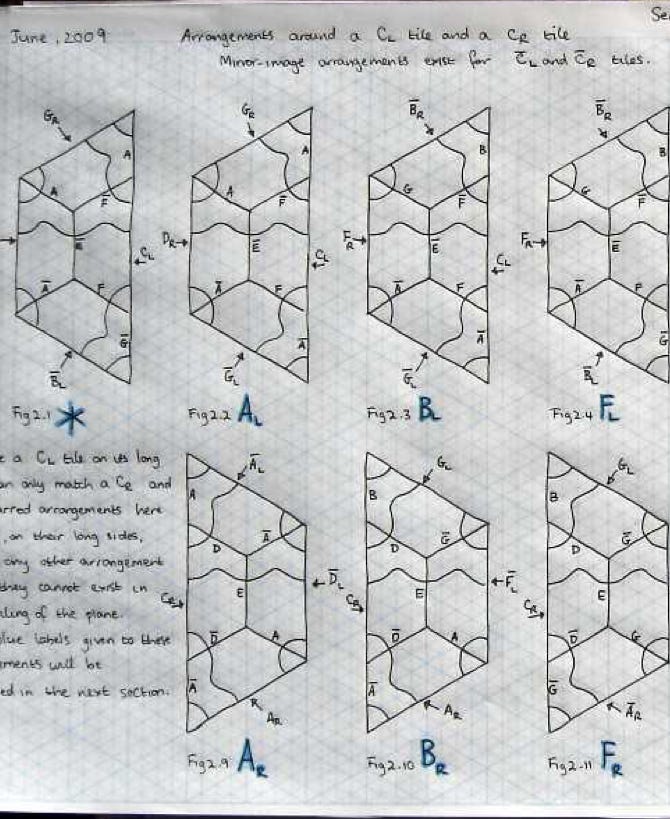

The news this week from math-land amounts to the discovery of a unicorn. A team of mathematicians and computer scientists led by an amateur enthusiast have announced the existence of something long thought to be impossible – a single shape that can fill a plane completely in an irregular fashion without leaving gaps. And here I report on a fabulous feminine dimension to the story that has been under-valued in the surrounding media frenzy.
The conceptual object under scrutiny is formally known as an ‘aperiodic mono-tile,’ though it is anything but monotonous. To understand its near-mythical character we can look to a bathroom floor.
All of us have probably gazed down from a seated perch to see how a floor can be covered with hexagons: such a consistent tiling is called ‘periodic’ because the pattern endlessly repeats.
We can also fill a plane with squares or equilateral triangles, and in the nineteenth century mathematicians found there are 17 distinct ways to tile a plane in a regular way without gaps. [1] All these patterns repeat like soldiers in formation. But can we fill a plane with some kind of pattern that doesn’t repeat? It sounds like an oxymoron – aren’t patterns by definition ‘regular’?
For a long time, such ‘aperiodic’ tilings were believed to be impossible as they seemed to defy both common sense and geometric intuition. Indeed, the great logician Hao Wang conjectured in 1961 that such patterns were against the laws of reason.
Two years later his own student discovered a set of tiles that could cover the plane in a non-repetitive fashion – however, more than 20,000 different shapes were needed. A race was now on to find a simpler set.
Soon Roger Penrose, the theoretical physicist who mentored Stephen Hawking, found just two tiles that achieve this magic trick – he nicknamed them the ‘kite’ and ‘dart.’ There was something else wondrous and strange about Penrose’s discovery: although the pattern never iterated precisely, it clearly had some kind of order because certain sections kept reappearing. In a deep sense, this tessellation was both ordered and disordered hovering at a conceptual boundary.
One stone to rule them all
Mathematicians began to wonder if they could achieve this feat with a single tile, one shape to cover the plane, as a hexagon can, but without repetition. This week’s news announces the discovery of such a ‘mono-tile.’ Whats special about it is that it can only fill the plane in a disordered way - you can’t force it to be ordered.
In a quirk of linguistics, it’s also known as an ‘einstein’ tile, not because its brainier than other tiles (though perhaps it may be!), but because ‘ein stein’ means ‘one stone’ in German. One stone – one shape – to rule the plane, binding the space together in a unitary embrace.
To everyone’s surprise, this einstein tile turns out to be far simpler than expected. It’s made up from 8 kite-shaped tiles stuck together in a cluster resembling a wonky fedora and has therefore been dubbed ‘the Hat.’ [2]
More unexpected still, the Hat turns out to be the first in an infinite series of similarly endowed shapes each of which can fill the plane aperiodically. It’s as if having found one unicorn, mathematicians have gone on to discover a whole taxonomy of unicorn-cousins, any of which can achieve the magic tessellation trick in its own fashion. So, what was once thought to defy logic has now been revealed as possible in an infinite variety of ways.
White Queen wonderings
Such aberrations of ‘reason’ were what mathematician Charles Dodgson – aka Lewis Carroll – was referring to when he had the White Queen say to Alice that on a good day she could “believe six impossible things before breakfast.”
Dodgson lived at a time when mathematicians were beginning to discover all sorts of other ‘impossible’ things: a surface with only one side (the Mobius strip); the Klein bottle (a bottle-like form which also has just a single side); and spaces with more than three dimensions – as many dimensions as you like! Plus things called matrices, grid-like arrangements of numbers that add, subtract, and multiply together in odd ways.
Apparently, Queen Victoria was so enchanted with Alice in Wonderland she asked Dodgson to dedicate his next work to her, and he duly obliged by sending her a monogramed copy of a research paper on matrices, about which he was an expert.
Curiouser and curiouser
As if our mono-tile tale were not curious enough, the lead author of the new paper is a retired printing technician from Bridlington in East Yorkshire, England, with no formal math training. “I’m always messing about and experimenting with shapes,” David Smith told The New York Times, describing himself as a shape hobbyist, which sounds like just the kind of vocation one might find in Wonderland.
On Wednesday I sat in on a Zoom Q+A with Smith and his team organized by the Museum of Mathematics in Manhattan in response to what can fairly be described as an outpouring of public interest in the discovery.
Youthful, sixty-something, sporting salt-and-pepper stubble, a leather jacket and bandana, Smith looked more like an ex-punk rocker than an aspiring mathematician, which suggests that stereotypes about what a mathematician is – or should look like – need to be exploded. Asked how he came to his discovery, Dave (as he prefers to be know) rejected any intimations about theoretical proclivity and insisted: “I just like to play around with shapes.”
Prior to teaming up with the mathematicians who worked through the proofs for his tile, Smith cut out dozens of Hat shapes from card stock and arranged them by hand on a tabletop, gradually getting “a feeling” for their extraordinary nature. Once his intuition was satisfied only then did he approach the experts.
During the Zoom he seemed ever more modest, quiet, enigmatic, like a mathematical version of the inscrutable hero of Being There. His very name “Dave Smith” bears resonances with another beloved amateur who triumphs in a world of seasoned professionals – the character played by Jimmy Stewart in Frank Capra’ 1939 film Mr. Smith Goes to Washington. In both instances, a rank outsider brings gentle insight, and dare we say a sort of commonsense beauty, to a field normally perceived as the exclusive purview of a connoisseur class.
Hand-drawn mathematics
And this isn’t the first time an outsider has contributed to world-class tessellation research. In 2009, Joan M. Taylor, a woman living in northern Tasmania, wrote a paper presenting another version of an einstein tile complete with exquisite, lace-like, hand-drawn illustrations. Taylor also then teamed up with a professional mathematician, Joshua Socolar at Duke University. Their tile caused a sensation too, not least because Taylor’s paper became public just months after Penrose had given a talk at an international conference in which he admitted he’d been unable to solve the mono-tile problem. Given that he’d go on to win a Noble Prize for his work on the theory of black holes, Taylor’s achievement becomes all the more remarkable. [3]




The Socolar-Taylor tile was the first known instance of an einstein tile, but it consists of half a dozen disconnected pieces so it’s formally referred to as a ‘proto-tile.’
It’s understandable why mathematicians still longed for a single connected shape, though in some ways Taylor’s tile seems more fantastical to me than Smith’s because it’s so downright weird – it looks like a refugee from a 1980’s video-game, a spikey pixelated Pacman figure. One would never imagine such an odd formation could fill the plane completely as we see in the illustration below
Both Taylor and Smith present us with inspiring examples of amateur genius, “beautiful minds” trained under their own volition guided by some intricate inner compass toward mathematical rigor. It all makes me wonder how many more non-professionals there may be in off-the-chart locales like Bridlington and Tasmania quietly discovering truths about the ways of numbers and forms.
END NOTES
[1] Formally, there are 17 distinct combinations of convex polygons that can be arranged to form tilings of a plane, or what are known as plane-vertex tilings.
[2] The kite tiles that make up the Hat are slightly different to Penrose’s kite. Both are symmetrical parallelograms that look like actual kites, but the Penrose kite has very specific side lengths related to the golden ratio.
[3] There have also been other amateurs who’ve made discoveries about tiling patterns. See here for this lovely article in Quanta magazine that discusses several others.










